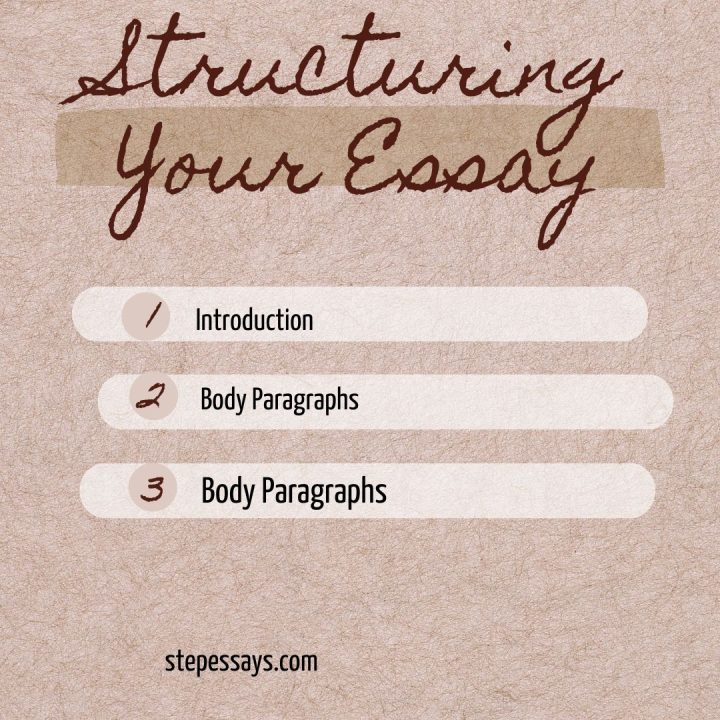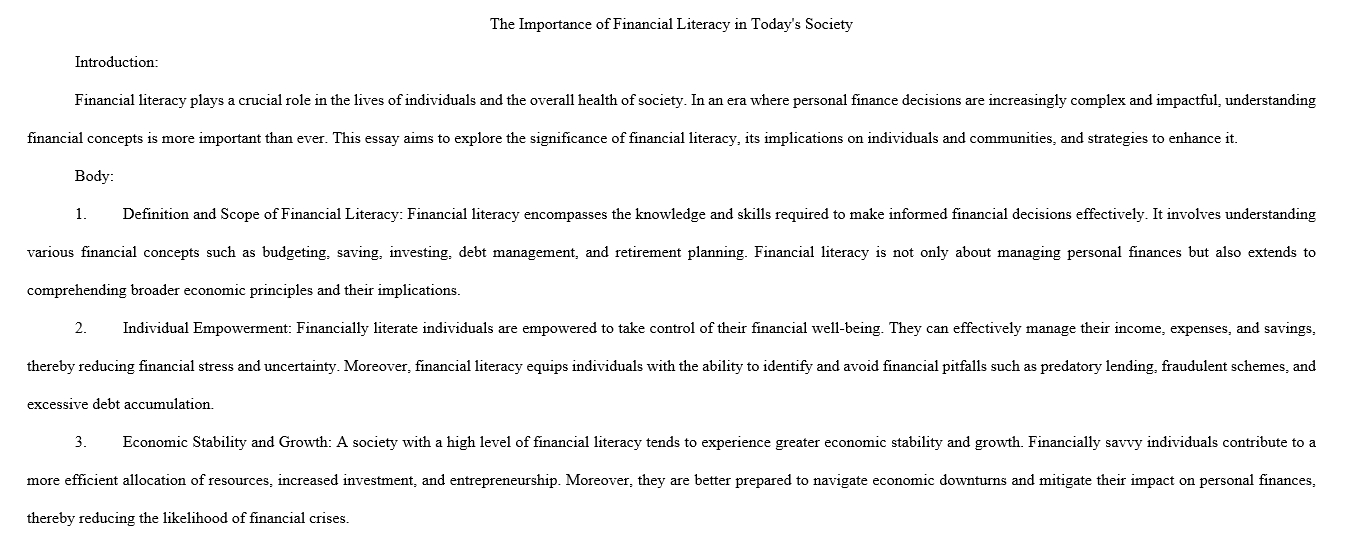Abstract:
Composing an exemplary explanatory essay requires a strategic approach that balances meticulous research, thoughtful analysis, and eloquent expression. This abstract looks into the essential elements of crafting such a paper. Beginning with a captivating introduction, the essay hooks the reader’s interest and presents the overarching thesis statement. As the essay unfolds, each body paragraph systematically explores distinct facets of the topic, supported by thorough research and compelling evidence. Each argument is meticulously analyzed, providing clarity and depth to the discussion. Effective transitions ensure a seamless flow between ideas, guiding the reader through a coherent narrative. In the conclusion, the main points are succinctly summarized, and the broader implications of the discussion are considered, leaving the reader with a profound understanding of the topic. Through this structured approach, writers can create explanatory essays that inform, engage, and inspire readers to explore deeper into the subject matter.
Introduction:
1. Understanding the explanatory essay:
2. Research and Gather Information:
Developing a thesis statement is a critical aspect of mastering the art of writing explanatory essays, as it serves as the guiding beacon that directs the entire essay’s focus and argumentation. A well-crafted thesis statement succinctly articulates the main idea or argument of the essay, providing a clear roadmap for both the writer and the reader. It should be specific, debatable, and supported by evidence, encapsulating the central claim that the essay seeks to explore and explain. Additionally, a strong thesis statement often reflects the complexity of the topic, inviting effective analysis and interpretation. Furthermore, it should be flexible enough to evolve as the essay progresses, accommodating new insights and evidence that may arise during the writing process. By mastering the art of developing a thesis statement, writers can effectively orient their essays towards a coherent and compelling exploration of the chosen topic, engaging readers in a thought-provoking journey of discovery and understanding.
-
Outline the explanatory essay Structure:
Outlining the essay structure is a foundational step in mastering the art of writing explanatory essays, providing a roadmap for organizing ideas and developing a coherent argument. A well-crafted outline serves as a skeleton upon which the essay is built, delineating the main sections and subtopics that will be explored. Typically, the essay structure includes an introduction that introduces the topic and thesis statement, followed by body paragraphs that each focus on a specific aspect or argument related to the thesis. Within each body paragraph, evidence and analysis are presented to support the main points, with transitions ensuring smooth flow between ideas. Finally, the essay concludes with a summary of the main arguments and a restatement of the thesis, leaving the reader with a lasting impression of the essay’s significance. By meticulously outlining the essay structure, writers can effectively organize their thoughts, maintain coherence throughout the essay, and guide readers through a clear and logical progression of ideas.
-
Write the Introduction:
Writing the introduction is a pivotal aspect of mastering the art of writing explanatory essays, as it sets the stage for the reader’s understanding and engagement with the essay’s topic. An effective introduction should capture the reader’s attention with a compelling hook or opening statement that arouses curiosity and establishes the relevance of the topic. Additionally, it should provide necessary background information to contextualize the discussion and introduce the essay’s main thesis or central argument. The thesis statement, usually placed at the end of the introduction, succinctly outlines the purpose and scope of the essay, guiding the reader on what to expect in the subsequent discussion. Moreover, the introduction serves as an opportunity to establish the writer’s credibility and authority on the topic, demonstrating their expertise and perspective. By skillfully crafting introductions that grab the reader’s attention, provide necessary context, and clearly articulate the essay’s main argument, writers can effectively lay the groundwork for a compelling and informative explanatory essay.
-
Craft Body Paragraphs:
7. Provide Evidence and Analysis:
-
Address Counterarguments:
Addressing counterarguments is a crucial aspect of the art of writing explanatory essays, as it demonstrates the writer’s ability to engage with alternative perspectives and strengthen the overall credibility and persuasiveness of their argument. By acknowledging and refuting potential objections or opposing viewpoints, writers show a depth of understanding of the topic and a willingness to engage in a balanced and processed discussion. Addressing counterarguments involves anticipating potential objections that readers may have and presenting evidence or reasoning to rebut these objections effectively. This not only strengthens the writer’s own position but also demonstrates intellectual honesty and integrity. Furthermore, addressing counterarguments can help broaden the scope of the essay by exploring different facets of the topic and engaging with a wider range of perspectives, ultimately enriching the reader’s understanding and appreciation of the complexity of the issue at hand. In doing so, writers can create more compelling and persuasive explanatory essays that resonate with readers and contribute meaningfully to the discourse surrounding the topic.
-
Conclude with Impact:
Concluding with impact is the final brushstroke in the art of writing explanatory essays, leaving a lasting impression on the reader and reinforcing the significance of the essay’s message. The conclusion serves as the summary of the writer’s arguments and insights, offering a synthesis of key points and leaving the reader with a sense of closure and understanding. To conclude with impact, writers should revisit the essay’s main thesis and recapitulate the key findings or insights presented throughout the body of the essay. However, rather than basically summarizing what has been discussed, the conclusion should aim to leave a memorable impression by providing a thought-provoking insight, a compelling call to action, or a profound reflection on the broader implications of the topic. By leaving the reader with a sense of resonance and significance, a well-crafted conclusion ensures that the essay’s message lingers in the reader’s mind long after they have finished reading, reinforcing the impact and relevance of the essay’s exploration of the chosen topic.
-
Revise and Edit:
11. Writing Style and Tone
Crafting an appropriate writing style and tone is crucial in mastering the art of writing explanatory essays. The style should be clear, concise, and formal, prioritizing clarity of expression and ease of comprehension for the reader. Since explanatory essays aim to elucidate complex topics or concepts, avoiding overly technical language or jargon ensures accessibility to a wide audience. Furthermore, maintaining a neutral and objective tone enhances the credibility of the essay, fostering an atmosphere of reasoned inquiry rather than persuasion. However, this does not mean sacrificing engagement or personality in the writing; injecting elements of creativity or personal voice can help maintain reader interest while still upholding the informative nature of the essay. Ultimately, striking the right balance between clarity, formality, and engagement in writing style and tone is essential for effectively conveying the intended message and engaging the reader in the exploration of the topic at hand.
12. Citing Sources
Citing sources is not just a technical aspect but an integral part of the art of writing explanatory essays. It adds credibility, authority, and depth to the arguments presented while acknowledging the contributions of others to the discourse. Incorporating citations demonstrates the writer’s engagement with existing literature and research on the topic, indicating a thorough understanding of the subject matter. Proper citation also upholds academic integrity by giving credit to the original creators of ideas, data, or quotations used in the essay. Whether following a specific citation style such as APA, MLA, or Chicago, adhering to consistent and accurate citation practices is paramount. Moreover, effectively integrating citations into the text requires skillful blending of quoted material or paraphrased ideas with the writer’s own analysis and interpretation, maintaining a balance between originality and reliance on external sources. By mastering the art of citing sources, writers can lend authority and credibility to their explanatory essays while contributing to the broader academic conversation surrounding their chosen topic.
13. Revision and Proofreading
14. Incorporating Evidence and Examples
Incorporating evidence and examples is the cornerstone of mastering the art of writing explanatory essays. These essays aim to clarify complex topics or concepts by providing thorough explanations supported by concrete evidence and relevant examples. To effectively incorporate evidence, writers must first conduct comprehensive research to gather credible sources and data. These sources could include scholarly articles, books, statistics, or expert opinions that lend credibility and depth to the essay’s arguments. Furthermore, selecting appropriate examples is crucial for enhancing clarity and understanding. Examples serve to illustrate abstract concepts, making them more tangible and relatable to the reader. Whether drawing from personal experiences, historical events, or case studies, the examples chosen should directly support the points being made in the essay. By skillfully weaving together evidence and examples, writers can construct compelling explanatory essays that engage readers and illuminate complex subjects with clarity and precision.
15. Selecting a Suitable Topic
Selecting a suitable topic is a critical first step in the process of writing an explanatory essay paper. It involves a delicate balance between relevance and personal interest. Writers should aim to choose a topic that not only aligns with the assignment’s requirements but also resonates with their own passions or curiosity. Narrowing down broad ideas through brainstorming techniques helps to focus the scope of the essay and ensures that the chosen topic is manageable within the given parameters. Additionally, considering the target audience is essential; selecting a topic that is meaningful and engaging to the intended readership enhances the overall impact of the essay. Ultimately, a well-chosen topic sets the foundation for a compelling and informative explanatory essay.
Structuring Your explanatory essay
A well-structured essay enhances readability and comprehension. Follow a clear organizational structure, typically comprising an introduction, body paragraphs, and a conclusion.

Explanatory essay paper
2. Body Paragraphs:
3. conclusion:
How to write body paragraphs in an explanatory essay
How to introduce a topic selection in an explanatory essay
How to structure an explanatory essay
Essay Example




